Preschool Inspirations
Preschool Activities and Learning

Super Fun Rainbow Science Activities Just For Kids
March 8, 2018 by Editor Leave a Comment
Rainbows are one of my favorite parts of Spring. It usually means that the sun is shining and I’m always happy with that. Even though it usually means it is raining as well, but I’ll take the sunshine when I can get it! Incorporating rainbows in science activities is not only fun but super easy. These Rainbow Science activities are perfect for the classroom or at home. Most of them don’t require much prep but all of them will have kids smiling in science giddiness!
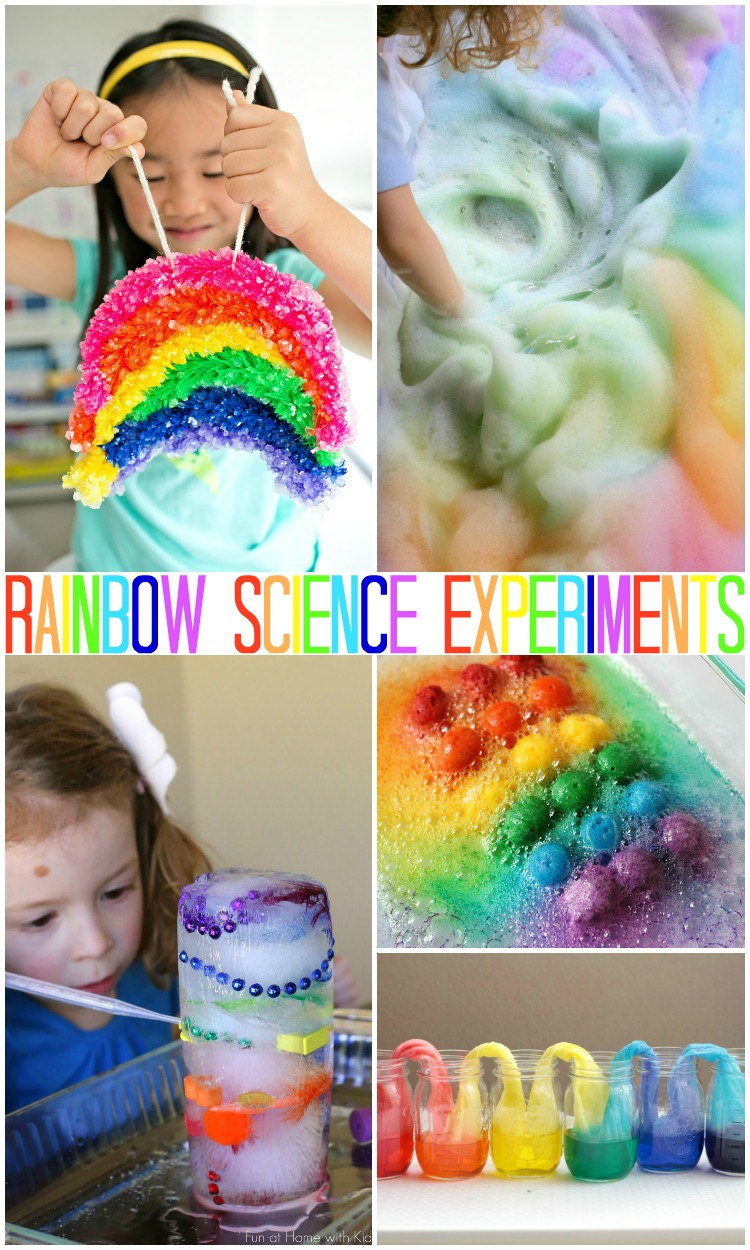
Rainbow Science Activities
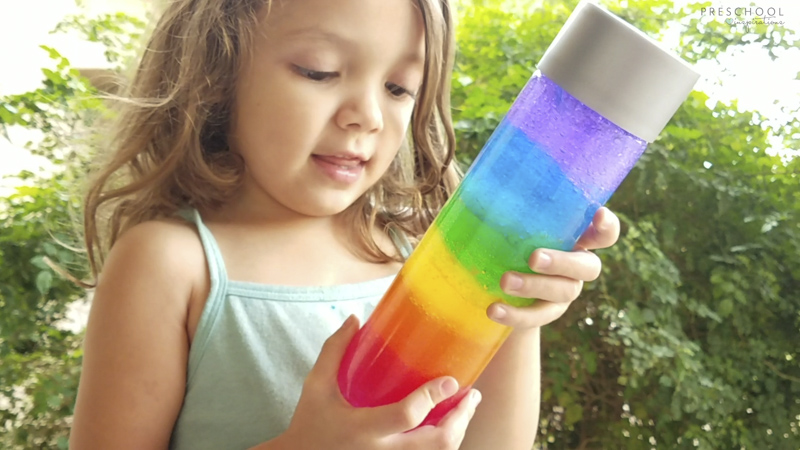
Finally a rainbow discovery bottle that the colors don’t run together! I’ve been trying and experimenting for a while now and finally figured it out! It’s not quite liquid and not solid either. It’s a perfect combination of awesomeness! Want to make one of your own? The full tutorial is here .

Get the best learning activities for 3-5 year olds at your fingertips
See inside the book!

We’ve all done baking soda and vinegar experiments, right? This Baking Soda & Vinegar Reaction though is the most colorful I have seen and I can just imagine how excited kids will be to see the rainbow foam explosions!
Oil and water make science experiments super easy and fun. This Rainbow Jar is extra fun, not only because of the colors, but it is mesmerizing how the colors stack up on top of each other!
These candies are fun to eat but even more fun to play with. This Skittle Rainbow is beyond the best candy experiment I have seen. I could watch this for hours!
Chromatography is a fun way to incorporate science and art together. These Rainbow Filters are fun to create but then also fun to create with!
Did you know that dish soap can do magical things? This Magic Rainbow Milk is purely magical. The colors move seemingly on their own, but are they moving on their own?
When science and sensory connect, it is always a great activity. This Scented Rainbow Science is perfect for sensory seekers! Plus, adding the scent is probably the easiest part!
This Exploding Rainbow is exciting to create and even more exciting to watch. Kids will enjoy these hands-on mini ‘explosion’. Even if we know it is only a simple reaction, kids will love to pretend their rainbows are exploding!
There is something incredibly fun about swirling your hand around in a big bowl of soap foam! This Rainbow Foam Bubbles activity is not only a fun sensory activity but also helps teach about color mixing as well.
Rainbows are pretty but Giant Crystal Rainbows are even more beautiful. Kids will enjoy watching the crystals grow on their rainbow! It may take a day but the magic of the crystallizing process will not be lost!
This Fizzy Rainbow Slush takes baking soda and vinegar to a whole new level. Plus if it is hot outside, you can place this slush in the fridge for a while and the kids can play in cold slush!
This Rainbow Sugar Water Density shows that adding sugar to colored water can help the colors separate instead of mixing together, which is excellent for younger children. This is also a fantastic way to introduce or teach about density for older children!
Pumpkin Seeds are not only for fall. These Pumpkin Seed Discovery Bottles are rainbow all the way and is a go-to activity for any time of the year!
Do your kids love playing with ice? And melting ice with hot water? This Rainbow Ice Tower is filled with colorful items frozen into a tower and the excitement is getting them out! I can see kids being occupied for quite a while with this one!
Science these days is not complete without slime and this Rainbow Slime is a MUST. It is absolutely beautiful how the colors connect but don’t mold together. This recipe is anything but icky!
Just like with the skittles experiment above, this M&M Rainbows is mesmerizing! It is incredible how candy can taste AND look so beautiful!
I love how this Erupting Rainbow comes out of little test tubes. Kids will feel like real scientists even though this experiment is incredibly simple!
This twisted rainbow is sparkly in all the right ways. Kids will enjoy creating this Salt Crystal Rainbow and displaying it all Spring long!
Sometimes science is simple and other times it is purely magical. The art that this Rainbow Paper experiment can make is fantastic! This would be beautiful to put on the front of cards or notes!
This Walking Rainbow experiment has me screaming HOW in my head. I want to explore this experiment because it just looks unreal. Science is so fascinating and this is one of those worldly mysteries that would be fun to solve!
This Ice & Salt Rainbow actually creates craters. As pretty as it is, it can do crazy things when combined together. This would be a fun science activity to add to a small world play with dinosaurs or superheroes!
This Rainbow Colored Ants activity is purely fascinating. This would be a fun lesson to teach for either a bug unit or even Spring. Super interesting!

Rainbows are beautiful in the sky and can create magic in the real world. These Rainbow Science activities are a close second to being magical in the real world. Whether you are teaching a spring unit, teaching about the weather or just wanting some fun colorful activities – these science activities are sure to please!
- Recent Posts
- November Preschool Themes You’re Going to Love! - October 12, 2024
- Valentine’s Day Letter Formation Mats - February 4, 2024
- January Preschool Themes You’re Going to Love! - January 1, 2024
Leave a Reply Cancel reply
Your email address will not be published. Required fields are marked *
Notify me of follow-up comments by email.
Notify me of new posts by email.
This site uses Akismet to reduce spam. Learn how your comment data is processed .
Get Your ALL ACCESS Shop Pass here →
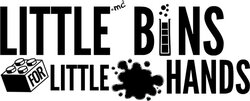
Rainbow Science Experiments
Everything is brighter with rainbows even a rainy day because that’s the perfect time to hope to see one! Whether you are looking for a pot of gold at the end or love the way the colors combine, exploring rainbows through science and STEM activities is a great way to get started! Find a fun selection of simple to set up rainbow science experiments to try out all year long. Any time of the year is perfect for exploring rainbows!
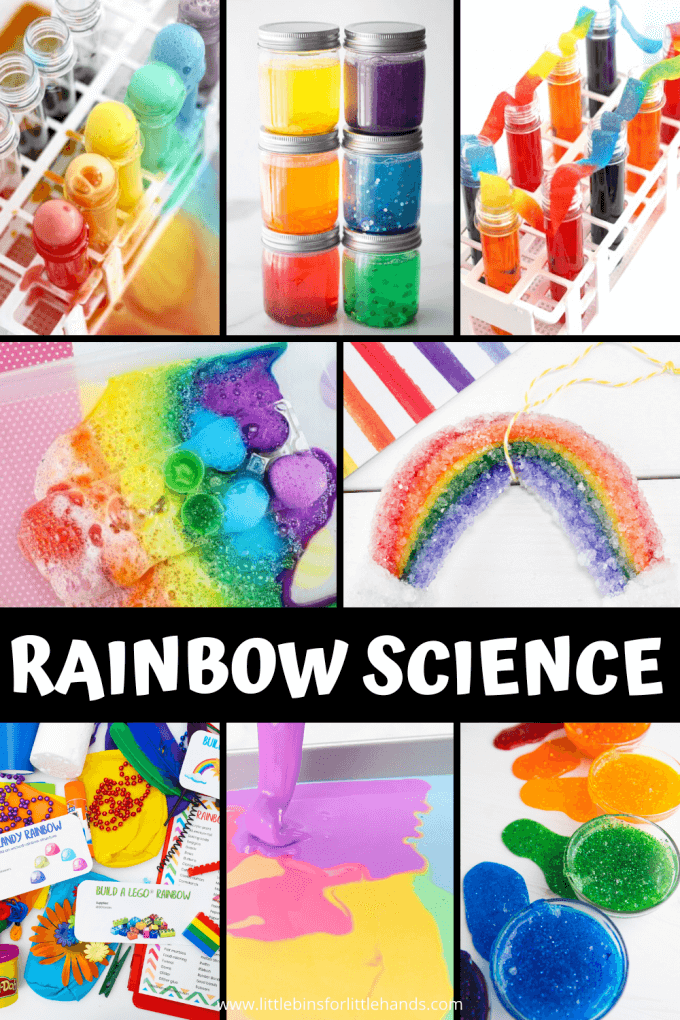
Explore Rainbows
Over the past year, we have explored rainbow and rainbow-themed science experiments. The difference? We have studied how real rainbows form and how light science plays a role in creating rainbows.
However, young kids also just love fun, rainbow-themed science activities that also showcase simple science concepts such as reactions , polymers , liquid density and crystal growing .
Below, we have included both kinds of rainbow science experiments. But before you get into all the fun, read on to learn some rainbow science.
How Rainbows Are Formed
A rainbow is formed when light passes through water droplets in the atmosphere. The water droplets break white sunlight into the seven visible spectrum colors. You can only see a rainbow when the sun is behind you and the rain in front of you.
There are 7 colors in the rainbow: violet, indigo, blue, green, yellow, orange, and red.
Make sure to look out for a rainbow next time it rains! Now, let’s try a rainbow science experiment or two!
Free Printable Rainbow Activities Guide and STEM Cards
Download this free mini Rainbow pack to get started today!

Want to turn a rainbow science experiment into a rainbow science project? Check out our easy science fair project ideas!
1. Make A Rainbow
Grab some prisms, old CDs and more, and explore how visible light can split into the colors of the rainbow.
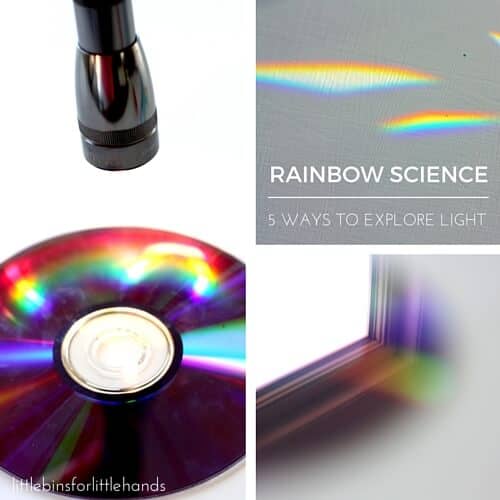
2. Rainbow Crystals
Grow crystals using a classic crystal growing recipe with borax and pipe cleaners. This rainbow science activity really grows awesome crystals that are both sturdy and beautiful to look at. Create a science craft with a pipe cleaner rainbow design!

3. Erupting Rainbow Science Experiment
A classic reaction for simple chemistry and a mix of colors to create an erupting rainbow!
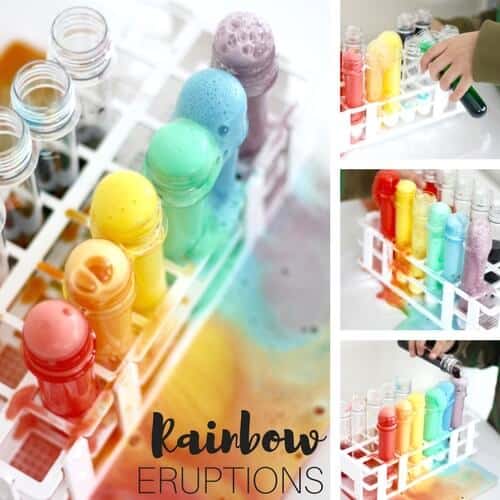
4. Walking Water Rainbow
This walking water experiment is incredibly easy and fun to set up for kids. Watch the water travel as it makes a rainbow of color, and learn about capillary action too!
Here is another way to set it up that’s great for groups of kids, and younger ages! See our grow a rainbow experiment.
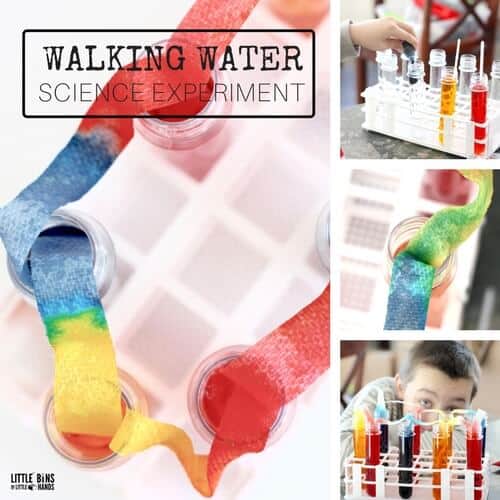
5. Build LEGO Rainbows
Explore symmetry and design with a rainbow LEGO building challenge.
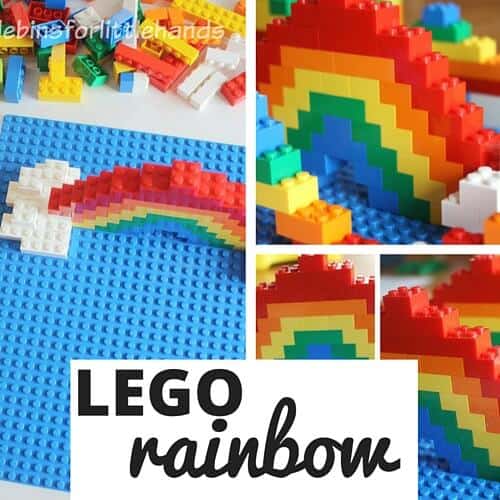
6. Rainbow Density Experiment
Super easy kitchen science using sugar, water, and food coloring. Explore the density of liquids to create a rainbow.
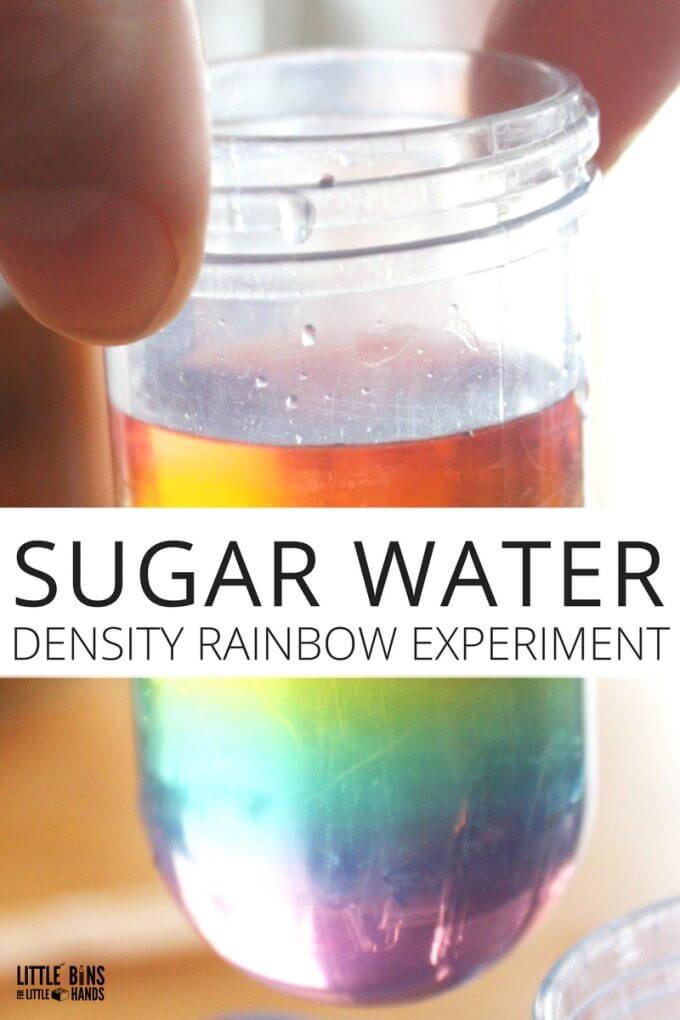
7. Make Rainbow Slime
Learn how to make the easiest slime ever and create a rainbow of colors!
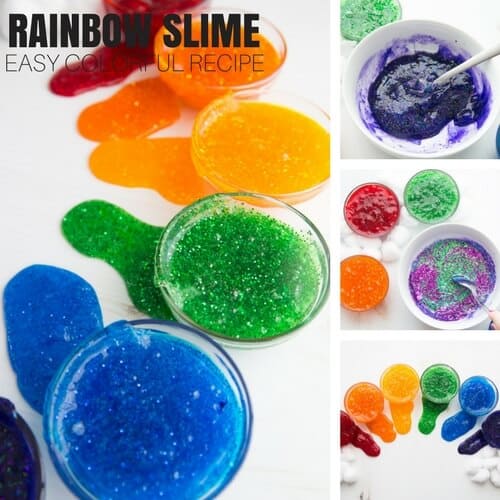
8. Rainbow Fizzing Pots
A leprechaun’s dream with a cool chemical reaction in mini black cauldrons!
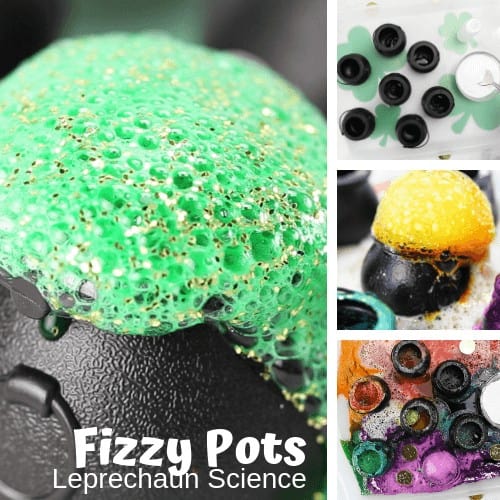
10. Rainbow Oobleck
Oobleck is an awesome science activity for exploring non-Newtonian fluids. Do you know what a non-Newtonian fluid is or how it works? Learn more through this hands-on activity that uses basic kitchen ingredients.
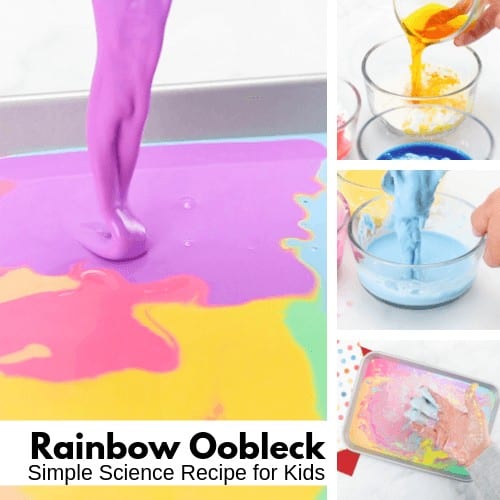
11. Rainbow Solubility
Make this fun rainbow craft with a few simple materials and explore solubility in the process.
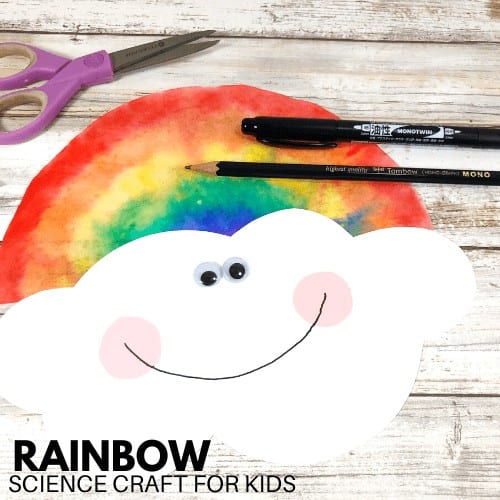
12. Make a Spectroscope
A spectroscope or a spectrograph is a scientific instrument used to study the properties of light. It breaks light down into different wavelengths, called a spectrum. It works similar to how a prism splits white light into a rainbow .
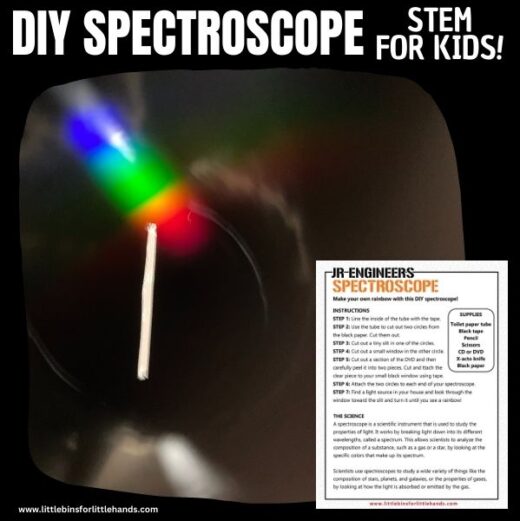
12. Grow a Rainbow
Explore capillary action with markers and paper towels. “ Growing a rainbow ” is a fun science demonstration for various ages!

More Fun Science Topics To Explore
- Baking Soda & Vinegar Experiments
- Simple Machine Projects
- Chemical Reaction Experiments
- Density Experiments
- Water Experiments
- Capillary Action
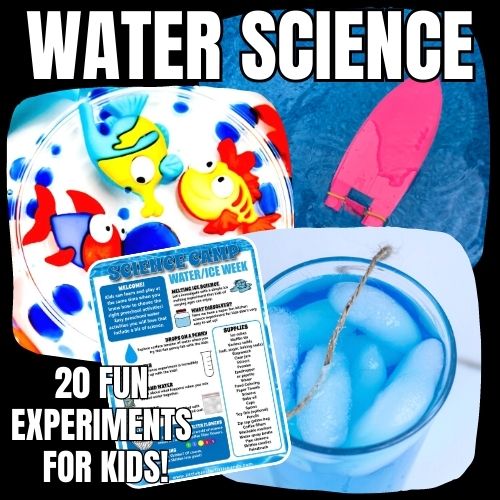
Helpful Science Resources To Get You Started
Here are a few resources that will help you introduce science more effectively to your kiddos or students and feel confident yourself when presenting materials. You’ll find helpful free printables throughout.
- Best Science Practices (as it relates to the scientific method)
- Science Vocabulary
- 8 Science Books for Kids
- All About Scientists
- Free Science Worksheets
- Science Supplies List
- Science Tools for Kids
Printable Science Projects For Kids
If you’re looking to grab all of our printable science projects in one convenient place plus exclusive worksheets and bonuses like a STEAM Project pack, our Science Project Pack is what you need! Over 300+ Pages and 90 projects!

- Pingback: Make Rainbow Slime Recipe for Amazingly Colorful Homemade Slime
- Pingback: St Patricks Day Chemistry Experiments (that are actually easy to set up!)
I love using your projects with my grandson. I am now faced with distance learning for my students. I am a STEM teacher at an elementary school. A lot of your project lend themselves easily to distance learning. What is your position on using some of your projects in my Google Classroom? Please advise. Thank you.
Comments are closed.

Subscribe to receive a free 5-Day STEM Challenge Guide
~ projects to try now ~.
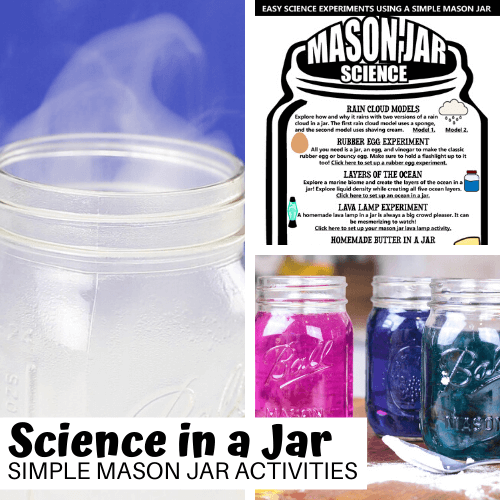
- Skip to primary navigation
- Skip to main content
- Skip to primary sidebar
Fantastic Fun & Learning
Fun learning activities and things to do with kids
Rainbow Science Experiments
By Shaunna Evans 1 Comment · This content may contain affiliate links.
Colors and rainbows provide so many excellent options for incorporating art and STEAM activities. And you know I love incorporating science experiments into our preschool theme activities . I thought you’d also like these fun rainbow science experiments. Use them as part of your preschool rainbow theme or any time to learn about colors and color mixing.
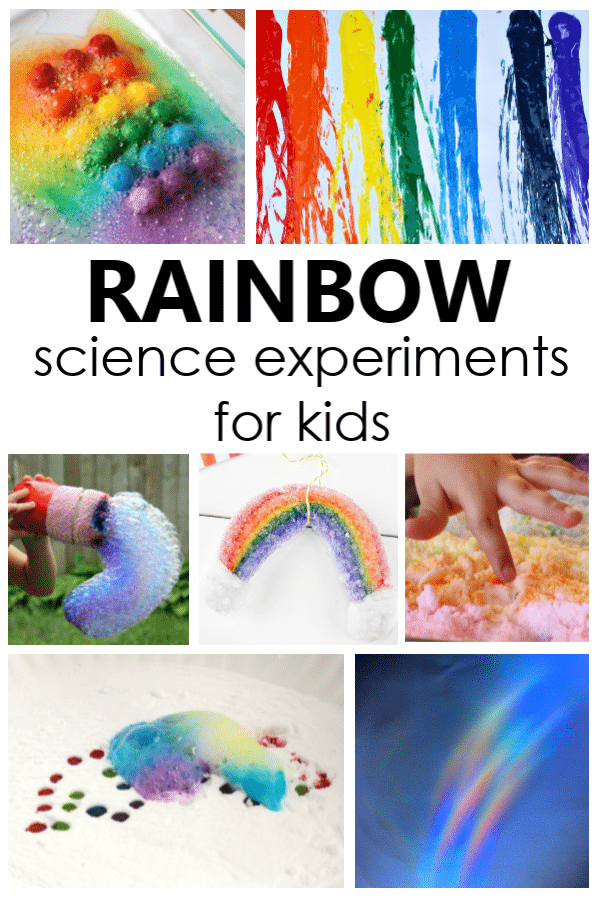
FIND EVEN MORE RAINBOW THEME IDEAS IN OUR PRINTABLE RAINBOW THEME LESSON PLANS
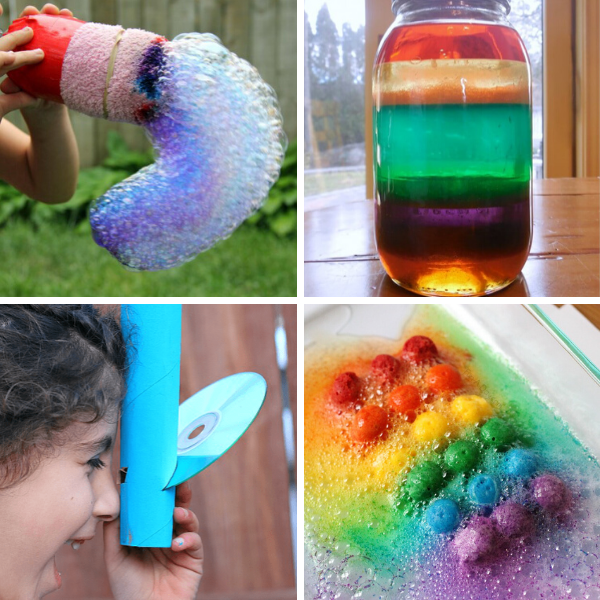
These Rainbow Bubble Snakes are so easy to make and use materials you probably have lying around the house.
With just a few simple ingredients, you can make your own Rainbow Jar .
Your kids will love exploring the spectrum of light sources with this Homemade Spectroscope .
If you are looking for a fun messy play activity for your kids, consider this Scented Rainbow Science and sensory play activity.

These fizzing rainbows are a great science experiment with bright and beautiful colors.
Grow Your Own Rainbow Crystals with this fun borax crystal growing activity.
Make your own pots of gold with these Rainbow Fizzing Pots .
Learn about how you can mix colors to create a rainbow in this Color Mixing activity.

If you’re looking for something fun and easy, you can’t go wrong with this Easy Make a Rainbow Experiment .
This fun Making Rainbow Reflections will teach your kids all about rainbows.
This fun Rainbow Science Absorption walking water activity is a fun recipe your kids will love.
Teach your kids about the different colors of the rainbow with this Fizzy Rainbow experiment.
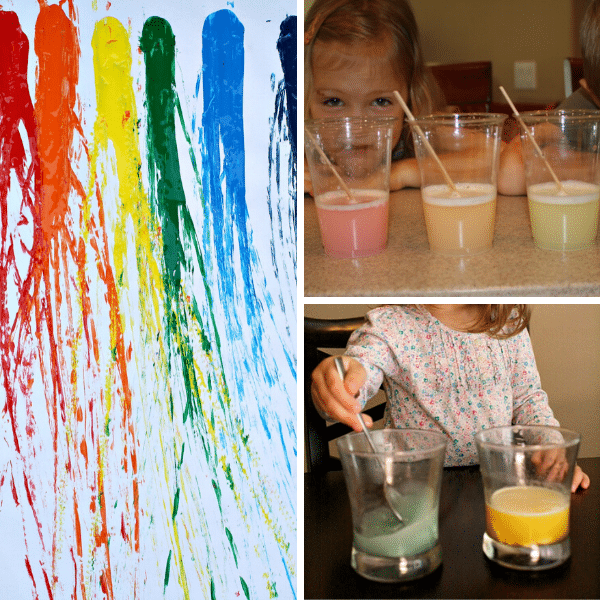
Learn what happens when marshmallows dissolve in water using this Marshmallow Rainbow Science Experiment .
Use cars and gravity to create this amazing and beautiful Rainbow Painting Gravity Experiment .
Your kids will love making their own candy heart rainbows in this Candy Heart Rainbow Science Experiment .

Get a full week of playful rainbow theme ideas!
Save time and get right to the playful learning with our printable lesson plan sets. Each set includes over 30 playful learning activities related to the theme, and we’ve provided different versions for home preschool families and classroom teachers so all activities are geared directly toward your needs.
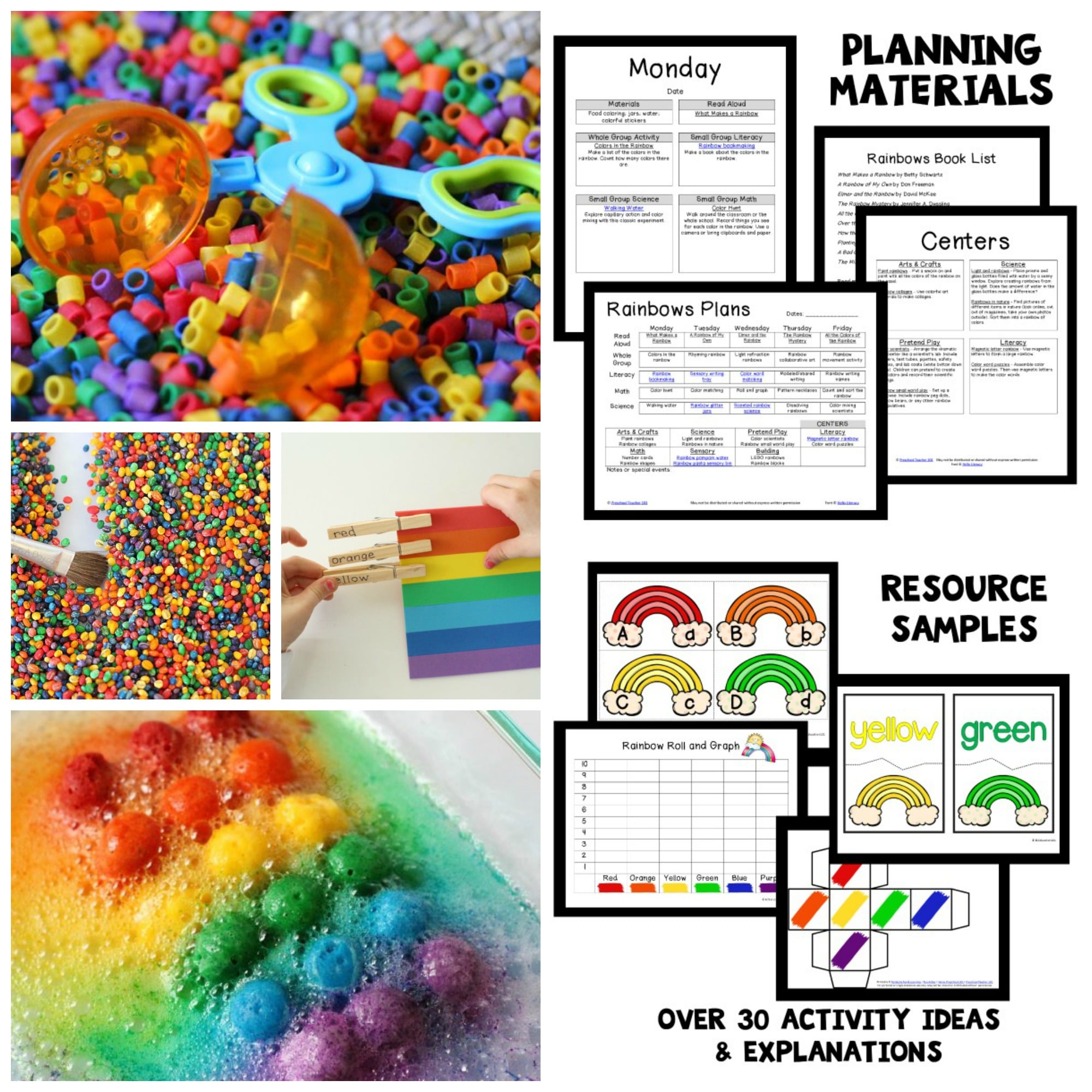
Get Your Copy

Also available on Teachers Pay Teachers .

Reader Interactions
March 12, 2014 at 1:22 pm
Thanks for featuring make the rainbow experiment!
Leave a Reply Cancel reply
Your email address will not be published. Required fields are marked *

Rainbow science experiments
Key points i covered in this post, what are the best methods for conducting rainbow science experiments, the science of rainbow formation, materials needed for creating a rainbow, step-by-step experiments, understanding light and color spectrum, applications of rainbow experiments in education, safety precautions for conducting experiments, what are some tips for conducting successful rainbow experiments.
- Maximize the light source to produce a more vivid rainbow, by using either direct sunlight or a high-intensity lamp.
- Adjust the angle of light entry when using prisms or water to change the display of the rainbow.
- Experiment with different types of surfaces to catch the rainbow for varied results, such as white paper, walls, or sidewalks.
- Try adding a few drops of milk to the water to enhance the visibility of the colors.
- Consider recording the experiments to analyze the results and observe subtle differences.
How can we create a rainbow in a classroom setting?
What materials are needed for a rainbow science experiment, is it safe for children to perform rainbow science experiments, what scientific principles can be learned from rainbow science experiments, can rainbow science experiments be tied into larger lessons on weather or optics, final thoughts, share article:, quick stem activities, rainbow slime.
- Activities for Kids
6 Incredibly Easy Rainbow Science Experiments
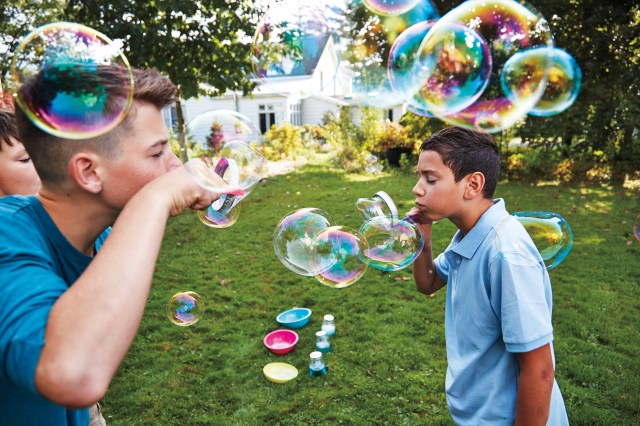
If you can’t find one, make one of your own, right in your kitchen, porch, or stoop
No rainbow in the sky today? No problem. Just pick one (or all) of these easy kid-friendly science experiments with your rainbow-making know-how. From reflection (mirror) to refraction (water glass) to learning about density, we’ve found six science experiments to make or learn from the rainbow. If you want more ideas, check out our sidewalk science ideas or dry ice science experiments .
1. The Mirror Method
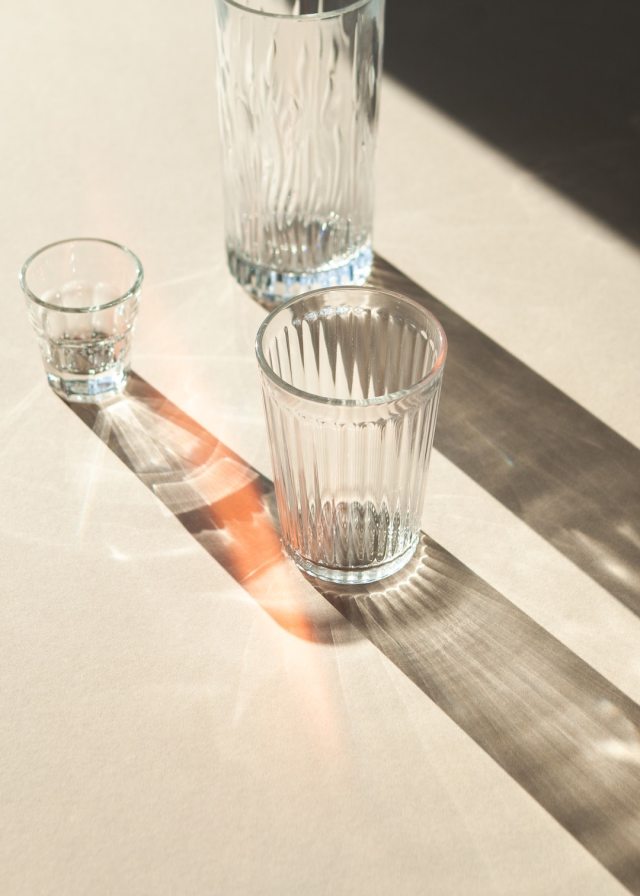
Lesson: Demonstrate the principles of reflection and refraction with this easy experiment . Light bending, aka refraction, takes place as light waves pass through the water. When you shine your flashlight (or position your glass so the sun comes in) you are bending the light waves, each one of the waves at slightly different angles resulting in the different colors of the rainbow. This is the same basic principle that occurs when water and sunlight create a rainbow in the sky. Reflection is the light bouncing off of the mirrored surface.
You will need:
A small mirror (like a compact mirror)
A glass of water (big enough to hold the mirror)
A flashlight (or sunlight)
A piece of white paper or a white wall
1. Put the mirror in the glass of water.
2. Turn off the lights and draw the curtains. Make sure the room is totally dark.
3. Shine the flashlight on the mirror and check out the cool mini-rainbows that appear above the mirror. Put your hand behind the glass for extra fun.
2. The Garden Hose Technique

Lesson: Refraction, as above. This time, instead of using a mirror to reflect the light, you are going to basically mimic the natural formation of a rainbow by causing the water to hit the light in a fine mist.
A spray bottle or a hose
1. Put the hose on mist or grab your mister and spray it into an area of your yard/house/garden that has natural sunlight hitting it.
2. Let the kids ooh and ahh over your rainbow-making skills, then let each of them take a turn.
3. Water Density Rainbow

Lesson: By adding more or less sugar to each water solution you are creating different density levels. When you add coloring to the glasses you will be able to see which solution is the heaviest. Add the colors in rainbow order to impress the kids. Visit Little Bins for Little Hands for the experiment that shows you how to make a rainbow.
Food coloring
Five glasses or plastic cups (clear)
4. The Glass o’ Water Approach
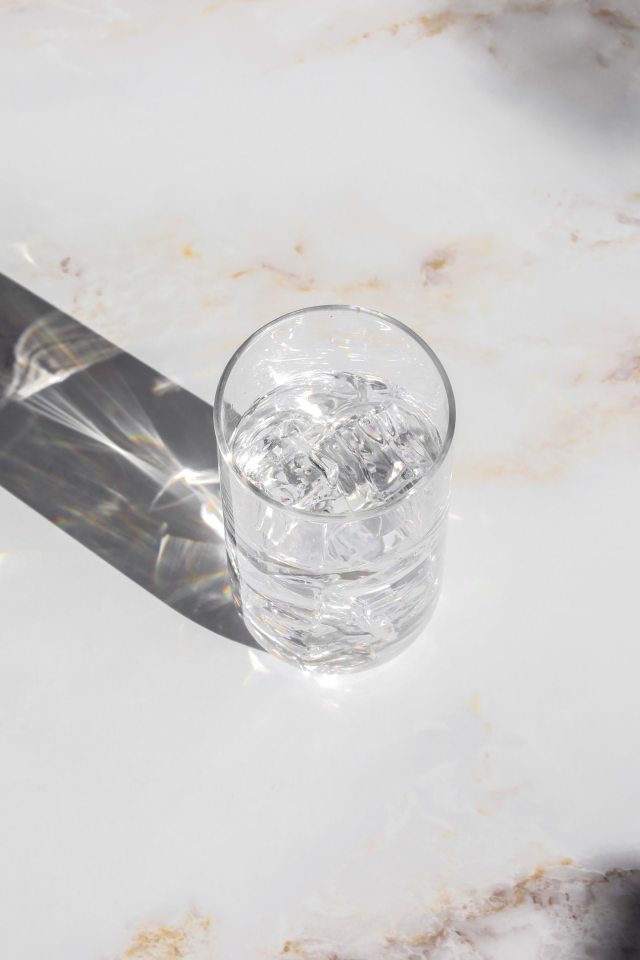
Lesson: The most simple form of light bending, this lesson in the light waves is similar to #1 above.
A glass of water
A piece of paper
1. Put the glass of water in the sunlight.
2. Put the paper next to it.
3. Let the sunlight stream through the water and create a rainbow on the paper.
5. Advanced Glass o’ Water Approach:
A spray bottle
1. Put the glass of water on a table or windowsill where there is sunlight.
2. Put the piece of paper on the floor where the sunlight hits, in the line of the glass.
3. Spray the window with warm water where the sun is coming through, and so it lines up with the paper.
4. Move the glass and paper around until you see a neat little rainbow on the paper.
6. The Bubble Method

It doesn't get any easier than making a rainbow by blowing bubbles. You can use regular dish soap and a bit of water and shake ingredients inside a bottle, or just blow bubbles and observe. Want to up the fun factor? Make your own bubble mixture out of ordinary kitchen ingredients.
Need some fresh ideas?
Subscribe to our weekly newsletter for expert parenting tips and simple solutions that make life instantly better.
By subscribing you agree to Tinybeans Terms and Privacy Policy
Related reads

Why Are Gen Z Kids Covering Their Noses in Family Photos?

Screen Time for Babies Linked to Sensory Differences in Toddlerhood, Study Shows

Kids Shouldn’t Have to Finish Dinner to Get Dessert, Dietitian Explains

The Questions Parents Should Be Asking Their Pediatrician—but Aren’t

6 Better Phrases to Say Instead of ‘Be Careful’ When Kids Are Taking Risks
- your daily dose

- and connection

- Your daily dose

- Skip to main content
- Skip to primary sidebar

This post might contain affiliate links. Click here for more information . Thanks for visiting!
15 Amazing Rainbow Science Activities
February 27, 2021 by Sheryl Cooper
Last Updated on May 9, 2024 by Sheryl Cooper
Inside: This collection of rainbow science activities is filled with fun. Fifteen ideas for toddlers and preschoolers that involve pouring, mixing, fizzing, and squishing while learning colors!
Exploring the rainbow is our favorite way to expose young children to colors and color mixing. I’ve share how we’ve made rainbows on bubble wrap and sorted rainbow colors in the sensory bin . But what about science? How can you wonder what happens while working with ROYGBIV? I’m thrilled to have found 15 rainbow science activities for toddlers and preschoolers .
Hands-on science that get young children excited about what will happen next!
Pouring, mixing, fizzing, squishing … ingredients that make early learning fun!
No time to read this now? Pin and save for later!

Some of these activities are more suitable for preschoolers than toddlers. Close supervision is required.
CLICK HERE for toddler rainbow activities!
15 Rainbow Science Activities for Toddlers and Preschoolers
Skittles Rainbow Science : What happens when you add skittles to water? (Fantastic Fun and Learning)
Spin Art Rainbows : What happens when you spin primary colors? A fun STEAM activity.
Scented Rainbow Science : What happens when you add vinegar to frozen baking soda? (Fun-a-Day)
Marshmallow Color Change Experiment : What happens to water after colored marshmallows are dissolved in it? (Fantastic Fun and Learning)
Colorful Water Beads Experiment : What happens when you hydrate colorful water beads? (Little Bins)
Sparkly Fizzing Rainbow : What happens when you add glitter to baking soda and vinegar? (Preschool Powol Packets)
Rainbow Paper Color Science : What happens when you dip black paper into clear nail polish and water? (The Science Kiddo)
Make Your Own Rainbow: What happens when you take everyday items and shine light on them? (Lemon Lime Adventures)
Rainbow Salt Discovery Jars : What happens when you color salt using chalk and add it to a jar? (Preschool Toolbox)
Exploring Prisms : What happens as the light from the sun passes through the prism? (Buggy and Buddy)
Rainbow Ice and Salt Experiment : What happens when you color a block of ice and then add salt? (Powerful Mothering)
Rainbow Density Jar : What happens when layer liquid mixtures that have different densities? (Schooling a Monkey)
Traveling Colors : What happens when you add the colors from the rainbow onto salt and glue? (You Clever Monkey)
Rainbow Water Xylophone : What happens when you fill jars with colored water, each at a different level? (Mama Papa Bubba)
Rainbow Clean Mud : What happens when you add toilet paper to soap flakes and colored water? (Simple Fun for Kids)
Check out our favorite science toys and materials:

More science ideas:
10 Simple Toddler Science Activities that are Full of Fun
How to Set up a Preschool Science Center
7 Preschool Science Experiments that Explore Gravity
Preschool Color Activity Plans
I am so excited to be a co-author of these color theme activity plans.
24 preschool learning activities for your colors theme, including literacy, math, science, art, fine motor, and more! A great resource for teachers and homeschoolers.
CLICK HERE for more information!

FREE CIRCLE TIME PLANNER!
Get your FREE circle time planner as a gift when you subscribe to my free weekly newsletters.
Here is my Privacy Policy
Success! Now check your email to confirm your subscription.
There was an error submitting your subscription. Please try again.
About Sheryl Cooper
Sheryl Cooper is the founder of Teaching 2 and 3 Year Olds, a website full of activities for toddlers and preschoolers. She has been teaching this age group for over 25 years and loves to share her passion with teachers, parents, grandparents, and anyone with young children in their lives.

IMAGES